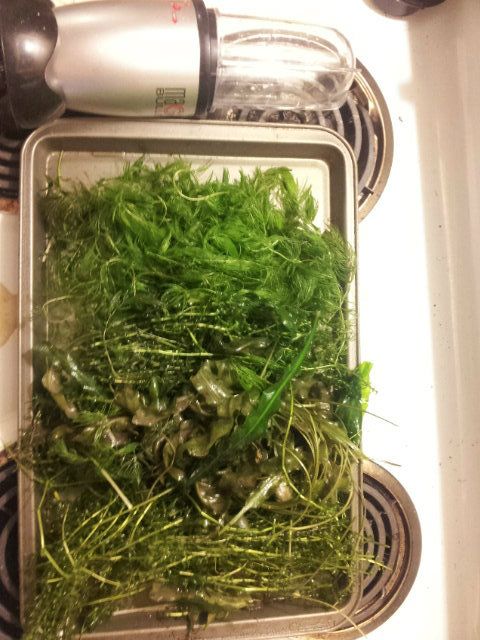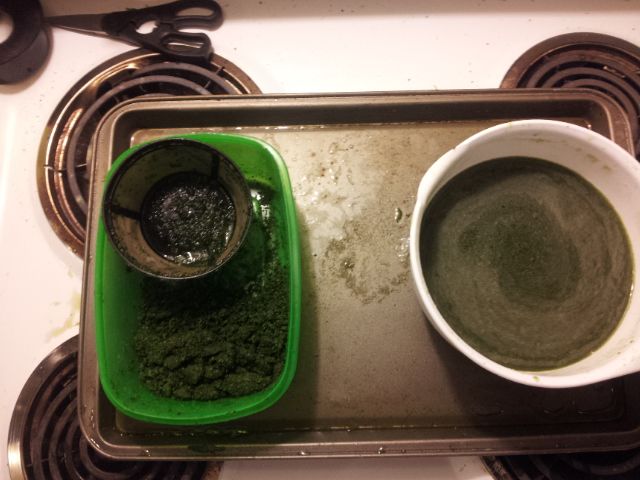even brine shrimp were, at one point, just another uncultivated oddity. so how does one start a new culture of live somethings that the pet trade may have never even heard of before?
as it turns out, it isnt that complicated. in fact, if you are just looking for something that might make a good live food someday without setting a specific requirement on what you might need or use, it doesnt even require any special work at all.
there are two ways of creating a new live food culture. one is finding a particular species wee beastie that you want to use for live food and learning how to grow it. for the this type pioneering work, you would need to learn as much as you can about the species in question and try to recreat ideal conditions for it to reproduce in. this is most people culture live foods, they aquire a culture that they want after or immediately before they do the research on how to keep it. keeping the culture alive is just a matter of giving it the right environment.
the second method is my personal favorite. it involves collecting several different species, giving them a specific environment, and seeing which species prefers that environment. this allows you to create a culture that is curtailed to the growing conditions that you are prepared to give them. the only down side is that you dont know if you are going to get something you will want. you may end up culturing millions of a small waterbug that would be great for adult fish, but would eat your 10 day old betta fry you are trying to feed. for this reason, you should only create such a culture purely for the sake of creating a genuinely new culture. my experience has been that you will eventually find a use/need for whatever you manage to end up with.
years ago, i used to go looking for specific bugs, collecting individuals from the wild and then learning as much as i could about culturing them. sometimes i was succeed, more often than not i would fail. after a while, i got tired of going back to the swamps/ponds/roadside ditches to collect more and more, so i just filled a couple five gallon buckets with water and mud from the bottom and poured them in a ten gallon tank. after i let it settle, i planned on using it as a little refuge to pull specimens from that i could work with.
it didnt take long for the initial "wild stock" to change. at first, i had worms, ostracods, copepods, and one or two daphnia. three weeks later, there were no more woms or daphnia, but the ostracods and copepods had trippled in numbers. i started isolating cultures of both, creating new tanks to put them in. the copepods would not survive a fast change in water quality but the ostracods did fine. eventually i learned how to culture both of them. after several trials and error, i learned that the ostracods could eat detritous, but the larvae would starve if the water column was too clean. the adults did not need suspended food matter food matter, but seemed to benefit if i gave it to them. all of the cultures flourished if i fed them some detritous and something that would stay in the water column.
i was 12 when i started the origional tank of pond water and mud. i was trying to learn how to culture those tiny little worms i would often find in the mud, but instead i ended up learning how to culture something that proved just as usefull to me that i hadnt even considered before. the things i learned from that first tank have allowed me to culture other species of ostracods in large enough numbers to easily use them as live foods. i also learned a lot about culturing copepods, but i never found a need for them since i was able to use ostracod eggs to produce live nauplii on demand that could fill the same role copepods would.
anytime we take somthing from outside, we are changing its environment. even if you were to leave the tank outside, you would still change the temp, circulation, ecology, etc of its occupants. this is one of the reasons i love this method so much. you never know what you are going to end up with, but you will know that whatever takes off can live and reproduce in the environment that you just gave it. that means a lof of the guess work is takien out of the equation. just keep doing what you are doing and you will at worst have enough specimens to attemt cultures on, and at best, have something that flourishes right at the get go.
in order for something to be usefull as live food, you have be able to produce it in large enough quantities to reqularly feed them off. so if you create a tank of water pulled from a wild source, and a month later you have a rediculous number of some crazy little bug, you already know that it can meet the reproduction requirements of live food.
my latest culture came from using this method. i wanted to get a culture of something that could be used as live food, but i wanted to be able to culture it in containers i left outside in the sun. so about a month and a half ago i was on my way to my inlaws house and i saw a small dry creek bed along thier half mile long drive way. about twice a year the creek flows for a couple weeks, so i figured it would be a perfect place to go try and collect my newest live food culture. after walking for about half a mile down the creekbed, i found a tiny puddle of water. i scooped up a bunch of sand and dead leaves, water, and clay and put them in an empty water bottle. when i looked at it, i saw thousands of tiny mosquito larvae, tiny scuds, and large copepods. after leaving it in a shallow cooler full of rainwater outside for a month, i checked on it and found a small daphnid, many small green ostracods, and thousands of small worms, about the size of grindal worms. when i started bringing in small cultures of the outside culture to gow the worms, the daphnids exploded. they went from barely beeing visible at all to producing a cloud that you cant see through(at least when they are feeding up near the light) in less than a week.
i origionally intended to culture the ostracods or the small scuds, and then the worms, but found something that will likely work great for feeding fry.
like i said, you never really know what you will get untill you try it.
Edited by Auban, 21 July 2012 - 12:42 PM.









